THE MAGIC OF MEMORIES
Goodness knows that accumulating years carry penalties. They come in myriad forms such as joint aches and pains, reduced flexibility, less energy, a penchant for procrastination, possibly declining creativity, and much more. There are, however, abundant blessings as well. As one of my favorite writers from yesteryear, Havilah Babcock, once suggested, “Boyhood improves with age, and the more remote it is the nicer boyhood seems to become.” Another favorite, Robert Ruark, couched things a bit differently but again focused on youth. “A boy has got to grow up to be a man some day. You can delay the process, but you can’t protect the boy from manhood forever. The best and easiest way is to expose the boy to people who are already men, good and bad, drunk and sober, lazy and industrious. It is really, after all, up to the boy, when all is said and done, and there are a lot of boys who never get to be men, and a lot of men who never quite cease being boys.”
I count myself as someone who has never quite ceased being a boy, and there is no question whatsoever that with each passing year my boyhood seems to me to become a bit better. That’s why memories are so magical, and in that regard I often think of the endless wonderful hours I spent with my Grandpa Joe. As I’ve frequently suggested, he was just a boy trapped in an old man’s body, and in many senses I reckon I fit that mold as well. At any rate, I know that looking back on a marvelously misspent youth gives me a great deal of joy, and I suspect exactly the same holds true for many of you.
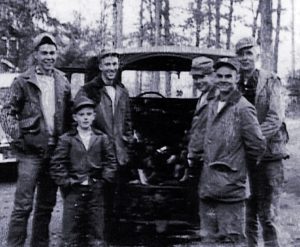
I’m fourth from the left and the three other teenagers are all high school hunting buddies. The older individual is Claude Gossett, my Dad’s favorite hunting and fishing buddy, and the young boy is Claude’s grandson, Bobby Childers.
With that in mind, I went back to an early rendition of this newsletter, one from July, 2007, where I looked at “The Changing Face of the Outdoor Experience.” I’d like to reprise some of what I offered then, modify it somewhat to take into consideration the passage of almost a decade and a half, and share those thoughts. If you have similar thoughts, or should you be able to add to my list, please do so and let me know about your own reflections. What follows is couched in terms of THEN versus NOW.
The overall nature of life in general, as well as the specifics of the outdoor experience, has changed dramatically. I’ll start with some basics of daily life THEN (in my boyhood) as compared to NOW. Back THEN we had no television, walked a mile to school from the first grade on, had a telephone party line shared with three other families, grew a big garden and canned a great deal of food, went barefooted all summer, had no air conditioning, daily ate three meals as a family sitting down together, spent a great deal of time on the porch of an evening, children had assigned chores from an early age, corporal punishment was accepted and approved in schools, most “toys” were homemade, boys and girls rode bikes often, teenagers seldom had vehicles, my allowance was a quarter a week (but a Saturday movie matinee with a cartoon and a serial only cost a dime, as did a fountain coke with a scoop of ice cream), youngsters could and did stay outside all day but you better be home for supper, and the entire community “took you to raise.” NOW every child has to have the latest in technological gadgets (I won’t attempt to explain them because they are beyond my ken—I still have a land line as a phone), communication is instantaneous and letter writing a lost art, every teenager thinks they should have their own car as soon as they get a learner’s permit, respect for one’s elders has greatly diminished, an air of entitlement pervades society, a strong work ethic seems destined for the endangered species list, and to me a confident sense of self-respect seems in abject decline.
Those are generalities, but let’s get down to specifics as they apply to the world of the outdoors and sport.
THEN: Boys (and girls for that matter, although obviously my personal perspective comes from the male side here and in what follows) had a role model or mentor, and in most cases many of them, who introduced them to the wonders of hunting, fishing, and nature in general. NOW: Folks willing to “pass it on” seem to be in singularly short supply. The explanations come from things such as children without a father figure (particularly prevalent in the black community but a general problem), fewer adults who hunt or fish, too much obsession with pursuing the almighty dollar at the expense of enjoying simple yet extremely meaningful things in life, the whole attitude of “it’s someone else’s responsibility” which is a tragic offshoot of the welfare state, and sheer self-interest.
THEN: Idling away summer days on the bank of a stream, spending joyful hours in the old swimming hole, taking all day fishing trips, running trot lines, watching set poles while sitting in the shade, skipping rocks, seining minnows, or any of many other pleasures associated with water and water sports. NOW: I don’t know when I’ve seen a youngster, or a bunch of them, out fishing or just being boys along a riverbank or at lakeside. They want to be in air-conditioned comfort with their iphones in hand.
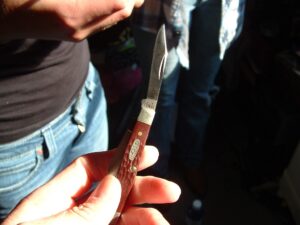
THEN: Every boy and every man, at least those with any self-respect and links to the land, carried a pocket knife. They wouldn’t have been caught dead without one, and young as well as old found daily uses for what is in many ways the ultimate tool. They also knew how to use a whetstone and would be embarrassed any time a trusty blade wouldn’t shave hair from an arm NOW: Boys seldom carry a pocket knife and they are total taboo on school grounds. Few men, other than those who farm or work with their hands, carry one either, and forget entering a public building or boarding an airplane with one. Officialdom will come down on you as if you personally are about to wreak havoc on half the population. I’m not exactly sure how we took all the steps to get to this point, but I am absolutely sure, as Grandpa Joe might have said, “I don’t like this thing some call progress,” at least when it comes to the matter of “concealed carry” for the humble pocket knife. As for shaving hair from your arm to check sharpness, that arm is likely to be adorned with tattoos.
THEN: If a boy was going fishing he didn’t buy a bunch of fancy plugs, baits, jigs, or flies. He dug red worms, caught night crawlers and spring lizards, seined for minnows, raided wasp and yellow jacket nests, or if he was a fly fisherman like me, searched every limb for the tell-tale sign of a bit of monofilament dangling down. If that was sighted, never mind how deep or how cold the water, retrieving the prize was obligatory. NOW: Bait is purchased in Styrofoam containers or, more likely, there’s a visit to a sporting goods store with a credit card or an amount of money which would have quadrupled my allowance for an entire year to purchase Mepps Aglias, Roostertails, or various lures in every color of the rainbow.
THEN: You could hunt almost anywhere, although occasionally when you sought permission the landowner would say you could hunt rabbits or squirrels (our normal prey) but “don’t shoot my birds.” Posted signs were scarce and when you saw one it invariably was connected with a piece of property held by an outlander locals derisively called “Floridiots” (if you are from Florida, don’t take offense—it was just that Florida folks were buying up a lot of mountain land and a good many of them brought along ways and an outlook on life decidedly out of tune with high country attitudes). About all that accomplished was to make the sign an immediate object of target practice. NOW: Posted signs are common as pig tracks, partly because of a great influx of outlanders but more thanks to the comeback of deer and wild turkeys. A sad sidelight to all of this is that I greatly fear public land hunting, at least as we’ve traditionally known it, will vanish in the next two generations.
THEN: Ammunition was affordable–.22 shorts cost a penny apiece or less if you bought in quantity while shotgun shells went for eight cents apiece or a baker’s dozen for a dollar. NOW: Ammo prices are through the roof and good luck on finding some calibers at any price.
THEN: You hunted waterfowl with lead shot and lost comparatively few cripples. NOW: Non-toxic shot is required with the results being either abortively high cost per shell or lots more cripples.
THEN: Wading gear for the trout fisherman consisted of an old pair of jeans and a pair of Army surplus boots a local shoe repair shop had outfitted with felt soles. NOW: There are waders for seemingly every season and condition and few folks “wade wet” anymore.
THEN: Standard hunting attire was Duxbak or else old overalls, a worn-out jacket, and surplus U. S. Army “combat boots” or possibly (if you had a bit of “cash money” to spare, L. L. Bean boots). NOW: You’ve got to have camouflage attire, which comes in more manifestations than Carter had little liver pills, and footwear covers so many areas, from special hikers to boots intended solely for upland bird hunting, that I reckon the properly outfitted sportsman needs a closet with approximately the same space for boots as Imelda Marcos had for shoes.
THEN: A boy could walk through a small town such as the one I grew up in carrying a shotgun or .22 rifle and draw no more attention than any other pedestrian. My brother, who drove a school bus when he was in high school, even carried a gun on the bus so he could do a bit of squirrel hunting after he completed his afternoon route. NOW: A youngster toting a weapon will have the wrath of the local gendarmerie descend on him like an old-time Bible thumper coming down on a bunch of half-soused bar patrons, and having a firearm in a vehicle at school is a fast-track method for expulsion or worse.
THEN: You didn’t need a hunting license until you reached 16 years of age, and it was common for boys as young as 12 years old to hunt alone. Yet they were safe and well-versed in sporting etiquette thanks to adult mentors. NOW: In some states merely clearing the path for a youngster to hunt involves braving a paperwork blizzard which would give a pointy-headed bureaucrat chronic indigestion, hunter education is mandatory, and licensing regulations can be quite complex.

THEN: Most folks hunted or if they didn’t had a full understanding and appreciation of the quest as wholesome recreation. No one gave so much as a second thought to the acceptability of the Second Amendment. NOW: You can’t get through a week’s worth of news on the television, in newspapers (which had a section in sports devoted to outdoors which is now largely extinct), or via the Internet without encountering ill-founded opinions, most based on profound ignorance, suggesting that banning any and all guns is the solution for most all societal problems. These are pretty much the same pundits who wouldn’t know souse meat from sugar-cured bacon or a pig’s tail from a pork chop, who suggest merely eating meat is cruel, and who couldn’t find their way out of a 100-acre forest to save their city slicker souls.
THEN: Sportsmen were not only the real conservationists; they were recognized and hailed as such. NOW: Sportsmen are still the true conservationists, but all sorts of liberal loonies who have never put their money where their mouths go want to control public lands, wildlife laws, guns, hunting, and what is a uniquely American way of life.
That’s but a tiny sampling of what I’ve seen change in my lifetime, and accuse me of being an old contrarian who refuses to move into the modern world all you wish, but I think the sportsman was held in far greater esteem THEN than he is NOW. That’s the cumulative result of a lot of things, most of them negative in my opinion, but I would put two things at the head of the list—an increasing loss of contact with the land and understanding of the cycle of life and growing urbanization. There are far too many folks who have not shared the blessings of traveling the life’s road I have and they don’t know where they are going because they have no guidance as to where sportsmen have been. That saddens me even as I am reminded of how lucky I’ve been to have had a life where hunting, fishing, close links to nature, and tilling the good earth were givens.
***********************************************************************************
LAUGHTER: THE BEST MEDICINE
Just a few days down the road I’ve got an appointment scheduled with a cardiologist. It is partly a check-up and also to determine if it’s safe for me to have another colonoscopy. I’m due and, never mind having reached the age when they stop for some, the presence of polyps in previous ones suggests I need it yet again. There’s absolutely nothing funny about the procedure, and anyone who finds humor in the lead-up to the procedure has a perspective on humor which differs dramatically from mine. That being said though, I did have an experience several decades ago involving the general part of the human anatomy associated with colonoscopies which I found somewhat funny at the time even though it was horribly embarrassing and unavoidable.
There was some kind of procedure for a rectal exam which involved blowing air up your innards rather than the flushing them out and using a sort of probe/viewing device to do the checking. I don’t know all the details except that it was in effect flatulence in reverse. The proctologist (or whatever the proper name for his area of medical practice was) had a pump-like device which attached to your rectum and inflated you like a balloon. He got me all hooked up and the air flow going good. It was uncomfortable at first and then increasingly painful. Eventually it reached a point where something had to give and I realized a verbal warning to the doctor and his nurse was in order. I said, in the clearest fashion possible, that there was an impending eruption if the input of air continued.
My warning went unheeded and within moments there was a blast of air which rattled instruments on the shelves and would have done the story of Geoffrey Chaucer’s “The Miller’s Tale” full justice (if you aren’t familiar with it, dig into The Canterbury Tales). Suffice it to say that not only was the release loud and sustained, it provided instant ease along with a degree of odiferous noxiousness which would have knocked a skunk off gut wagon.
I apologized as the gagging nurse fled the room but did manage to add something along the lines of “I told you so.” The doctor, who had had the good sense to be wearing a mask (the nurse wasn’t), just chuckled and said “Better out than in.” I wholeheartedly agreed, because the sense of relief which came with that air release was immense. I didn’t see the nurse again but rather suspect she had a different view of developments.
**********************************************************************************
JIM’S DOIN’S
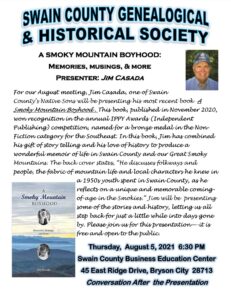
I’ll be heading up to my beloved Smokies in early August for a presentation on my most recent book, A Smoky Mountain Boyhood: Musings, Memories, and More, to the monthly meeting of the Swain County Genealogical and History Society. It is scheduled for 6:30 p.m. at the Swain County Regional Business Education and Training Center (45 East Ridge Drive, Bryson City, NC 28713). I’d love to have any readers who could make it in attendance at the event. It’s free (which may be about what anything I have to offer is worth). Earlier the same day, at 3:00 p.m. my brother, Don, will be leading a session at the local Marianna Black Public Library dealing with a vast collection of photographs made by an iconic mountain figure of yesteryear, Dr. Kelly E. Bennett. He was an avid and accomplished photographer and Western Carolina University recently acquired thousands of his images and has been busy digitizing them. Unfortunately most lack any identification of persons or places, and that’s one idea behind this first of what likely will be several meetings. Beyond that, it will serve as an initial opportunity to exhibit one man’s genius behind the lens as he captured numerous aspects of mountain life from the 1920s until the 1960s. I knew Doc Kelly personally and have warm memories of the man (his place of business, Bennett’s Drug Store, was THE hangout for local youngsters during my youth) and his family. If you would like to be taken back to Bryson City, Swain County, and the Smokies as they once were, I think you would find this gathering quite appealing. The library is located at 33 Fryemont Street in downtown Bryson City, just a block from the town square.
Thanks in part to the fact that I am, for once, somewhat timely with the July newsletter, I otherwise don’t have a whole lot to report. I’ve completed all the writing, preliminary work, first round of proofreading, and discussion of illustrative material on the book which at this point carries the title of “Nimrods in Africa: The Pioneers.” It contains 17 profiles of interesting and in most case important early hunters in Africa, going down through the Victorian era to 1910 (the end of the Edwardian era and the point of Theodore Roosevelt’s post-presidential safari). If this work receives a welcome reception from readers, and obviously I hope that will be the case, there will be two sequels—one covering the golden era of hunting in Africa from 1910 until mid-20th century with the other covering sporting scribes such as Robert Ruark, Ernest Hemingway, and Peter Capstick who captured the exoticism, danger, and romance of African hunting. If you want to be notified when the first volume appears, which will be in time for the Christmas season if all goes well, drop me an e-mail (jimcasada@comporium.net).
Beyond this particular aspect of my work I’ve got writing to do for two magazines where my byline appears with each issue, Smoky Mountain Living and Carolina Mountain Life (my latest offering here, in the Summer issue, is “The Hillbilly Highway and the High Counry”), my regular books column in Sporting Classics, contributions to Columbia Metropolitan magazine, and of course my weekly column for the little newspaper serving the town and county where I grew up, the Smoky Mountain Times. I’ve been writing for Sporting Classics almost all of its 40 years of existence (I started appearing in its pages in the magazine’s second year of publication) and my column has been in each weekly issue of the Smoky Mountain Times for almost 20 years. The continuity of those writing stints, and in each case they embrace multiple editors, are something I look back on with joy and, I must confess, what I hope is a bit of pardonable pride.
On the negative side of things I’ve never had such a disastrous year with gardening. Too much rain then too little rain has been a factor, as has my failure to stay on top of things the way I should. However, by far the biggest problem comes in the form of deer depredations. I’ve fenced (that’s a joke—a neighbor has an eight-foot high hog wire fence, tight as a tick, and they defeated it and deer-hogged his garden to the ground in one night), used hair clippings, tried cheap perfume, stretched fishing monofilament at various heights and in staggered form, tried peeing in strategic spots, and recently gave a long-nosed old doe a load of number eight shotgun pellets in the butt at about 35 yards. Other than the latter—the doe instantaneously realized her derriere was on fire and that she had urgent business elsewhere—it has been one exercise after another in frustration. A spray repellant I bought, and it ain’t cheap, seems to work pretty well, but I have to make new applications after every rain and it only lasts a few days even when it doesn’t rain. If you have a sure-fire or even somewhat certain solution, for goodness sakes let me know! Right now my only consolation comes when I’m eating a meal where venison is the main dish.
***********************************************************************************
RECIPES
Mid-summer means cookbooks, grilling, summer vegetables in abundance, fruits and berries offering dining pleasure unavailable at other times of the year, and much more. To my way of thinking, no single homegrown item offers greater difference from the supposed grocery shelves equivalent than tomatoes. You can readily obtain tomatoes in the grocery store throughout the year, but you I guess if would be equally possible to dine on wet cardboard at will. Maybe tomatoes from store shelves don’t quite fall to the level of cardboard, but to my way of thinking they are so inferior, so lacking in taste, when compared with a fresh, dead-ripe product of your home garden as to be almost unworthy of notice. I always plant too many, but I’d far rather have them to give away or to dehydrate than the alternative. Here are a number of recipes focused on one of the tree culinary wonders whether viewed from the perspective of taste, variety, versatility, health benefits, or about any other feature that might come to mind.
*********************************************************************************
MAKIN’S FROM MATERS
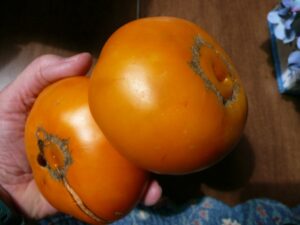
Along with corn, most consider tomatoes, usually just called “maters” in the traditional mountain vernacular of the place of my raising, the quintessential mountain garden goodness. Tomatoes are so wonderfully versatile, so tasty, and come in so many varieties as to be irresistible. Or as my Grandpa Joe was fond of saying, “I can’t imagine making a garden or passing a summer without plenty of maters.” He might well have added that when it came to the vegetable side of the equation, nothing remotely rivaled tomatoes in the array of offerings which graced Grandma Minnie’s table. From freshly sliced ones in the peak of summer to stewed tomatoes in the dead of winter, from savory soups to fried ripe ones (a tasty variant on the more common approach using green tomatoes), the crown jewel of his garden held wonderful sway throughout the year.
Blissfully, when it comes to tomatoes, the “good old days” shared with my grandparents and parents are even better today. Thanks to a grand resurgence of heirloom varieties, local seed and feed stores offering abundant options in terms of types of plants, pages of seed catalogs filled types to start from seed and then transplant, and local grocery stores and farmer’s markets featuring an abundance of tomatoes for those who don’t garden, no lover of luscious tomatoes need suffer so much as a hint of deprivation. From yellow pear-shaped gems of juiciness and bite-sized red “tommytoes” to scrumptious heirloom varieties such as Cherokee Purple, Black Krim, Mr. Stripey, and Brandywine; from paste tomatoes such as Roma to perennial favorites such as Rutgers, Big Boy, and Early Girl, there are tomatoes to feed every taste and culinary need. Here’s a sampling of makin’s from maters, but when you factor in Mediterranean cuisine, Tex-Mex dishes, soups, and other preparations; consider meat dishes in which they can play a key role; and keep in mind out-of-season options for their use, the only real limitation is the scope of your imagination.
MINI TOMATO PIES
INGREDIENTS
Phyllo shells
Sweet onions
Virgin olive oil
Fresh basil
Large slicing tomatoes
2 cups sharp cheddar cheese (Cabot’s Seriously Sharp is a good choice)
Salt and freshly ground black pepper
¾ cup real mayonnaise
Pre-bake individual phyllo shells. The number can vary, as can the amounts given below, depending on how many servings you want, but one pie per person is your guide. As the shells are baking, slice tomatoes fairly thin and lay them atop paper towels. Lightly salt the tops and let sit ten minutes before patting dry. Shred the cheese, adding salt and pepper to taste (remember that the tomatoes have been salted and even though patting will remove some of it a salty tang will remain).
Sauté sliced onions in olive oil. Mix mayonnaise with the cheese. Begin with a layer of tomatoes, then one of the cheese mixture, then onions and basil. Continue layering until each phyllo shell is filled to the top. Bake at 375 degrees for 30 minutes or until done.
TOMATO DILL SOUP
INGREDIENTS
1 stick butter
1½ large sweet onions pureed in a food processor
¼ cup fresh garlic, minced
1½ teaspoons dried dill
¼ tablespoon kosher salt
1/8 tablespoon freshly ground black pepper
9 cups tomatoes (crushed or diced—that equates to two 28-ounce cans plus one 14 1/2–ounce can—tomatoes you have grown, frozen, and thawed out are ideal for this recipe)
3 cups water
2 cups heavy cream (a pint of half-and-half with some whole milk added will work)
Place butter, onions, garlic, dill, salt and black pepper in a large covered pot. Sauté on low heat until onions are translucent. Add tomatoes and water. Simmer for one to two hours. Remove from heat and blend in cream.
STEWED TOMATOES AND OKRA
Cut a small cross or plus sign at the bottom of several dead ripe tomatoes and then dip in hot water for 15 to 30 seconds. This will loosen the skin and allow you to peel it away with ease. Cut out the core and quarter the peeled tomatoes. Set aside briefly while you prepare okra pods by cutting away the stem area. Pods can be cut into one-inch slices or left whole. Combine with the previously prepared tomatoes in a large cooking pot, add salt to taste along with a couple of slices of fried streaked meat (if desired), and simmer slowly (do not overcook, because everything will turn to mush). This dish does not look particularly appealing, and for some folks the slick or slimy nature of stewed okra is a turn-off. Visual aesthetics aside, this a grand vegetable dish. Leftovers can be used as the starting point for a big pot of vegetable or vegetable-beef soup.
BAKED EGGS AND TOMATOES
Slice away the bottom quarter of a large tomato and carefully remove any core that remains in the large section along with enough flesh to leave a cavity that will hold an egg. Place the tomato “container” atop a greased baking sheet or pan and carefully break a small or medium egg into it. Bake at 350 degrees until the egg sets to a point just short of the consistency your desire. Remove from the oven, sprinkle liberally with sharp, shredded cheddar cheese, then place back in the oven until the cheese melts. Eat piping hot.
PARMESAN CHEESE TOMATOES
Slice away the bottom of tomatoes and then sprinkle liberally with a mixture of Parmesan cheese and bread crumbs. You can buy crumbs but heels from a loaf of bread, given a quick whirl in a food processor, are much cheaper and work just as well. Bake at 375 degrees until the cheese/bread topping begins to turn brown and eat hot from the oven. If you have them, try leftover biscuits or crumbled cornbread as your crumb base.
SUMMER SALSA
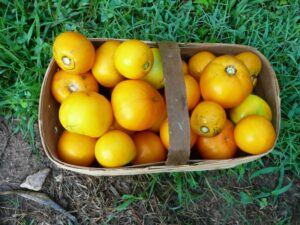
In the heat of summer, when tomatoes are abundant but thoughts of dealing with an oven or stove, cause dismay, here’s a grand way to use fresh tomatoes.
INGREDIENTS
2 or 3 large tomatoes, diced (a ulu is ideal for this task)
¼ cup finely chopped chives
½ cup chopped pimento olives
1 minced garlic clove
1 tablespoon red wine vinegar
3 tablespoons olive oil
Salt and pepper to taste
Combine the ingredients in a plastic or glass bowl, whisk gently, and let stand in refrigerator for 30-45 minutes.
NOTE: *Fresh mozzarella makes a nice addition to the salsa and it is an ideal accompaniment to grilled burgers.
TOMATO AND ONION PIE
Years ago a cousin, Joyce Casada Bryant, brought this dish to a family reunion. It drew rave reviews in a setting where a whole bunch of splendid cooks annually vied to outdo one another.
INGREDIENTS
1 refrigerated pie crust
8 ounces shredded mozzarella cheese
2 tablespoons chopped basil
4 large tomatoes, cored, peeled and sliced ½ inch thick
1 large Vidalia onion, sliced
½ teaspoon salt
¼ teaspoon black pepper
1/8 cup extra virgin olive oil
Fit the crust in a pan and spread the cheese over the crust. Sprinkle with basil and then top with slices of onions and tomatoes. Sprinkle with salt and pepper and then drizzle with the olive oil. Bake for 30 (or a bit longer if the pie is “shaky”) minutes in a 400-degree oven. Slice and serve.
**********************************************************************************
TOMATO TIPS FOR THE HOME GARDENER
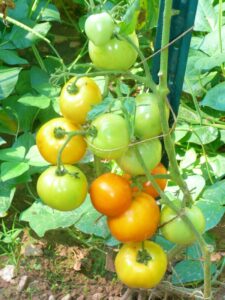
If you grow your own, and it is possible to produce an abundance of tomatoes in a very small piece of ground or even container gardens, here are a few tips for my half-century plus of gardening, supplemented by knowledge passed on to me by my father and grandfather, which might help when it comes to having plenty of tomatoes to use in these and other recipes.
*Rotate where you plant tomatoes from year to year. That helps keep various problems with blight at bay.
*Leave ample room between plants. That lets the plants breathe and works against too much moisture build-up and the progression of various tomato diseases.
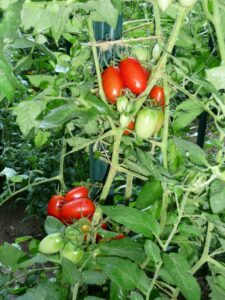
*Stake and prune plants religiously. I leave the sucker below the first bloom cluster and thus have two main stems. All other suckers are removed. Exceptions are Roma-type tomatoes and tommytoes. I don’t prune them at all and in the case of the latter keeping them supported is a real problem. They’ll run out the top of an eight-foot stake in no time at all.
*I don’t use any Sevin or other chemical treatments but I do plant marigolds between the tomato plants and vigilantly patrol for tomato horn worms. When I see the tell-tale signs of their depredations the search is on (fresh droppings help in locating these masters of camouflage) and when I locate the hornworm there’s a good squishing, with green juice a-flying, sending the pest the insect paradise.
*Perhaps the best tip I can offer involves removing leaf stems as soon as they show any sign of yellowing, black spots, or disease. They will usually break away from the main vine fairly easy. By mid-summer this will leave the lower reaches of the plant looking naked, but I’m convinced it works not only in keeping the spread of disease at bay but in letting the plant put all its energy into producing more tomatoes as the season advances. Don’t throw the diseased vegetation on the ground. I carry a five-gallon bucket with me and put the leaves in it as I move down the row. They then go straight to a burn pile well away from the garden.
*Keep the ground beneath the plants clean and free of weeds. I think mulch is a mistake. It makes a perfect home for disease. If it gets really dry and you need to water the plants, do so early in the day so that moisture on the plant will dry before nightfall.
*The varieties you plant are largely a matter of personal choice, but I would suggest experimenting with at least one new variety, along with old favorites, every year.